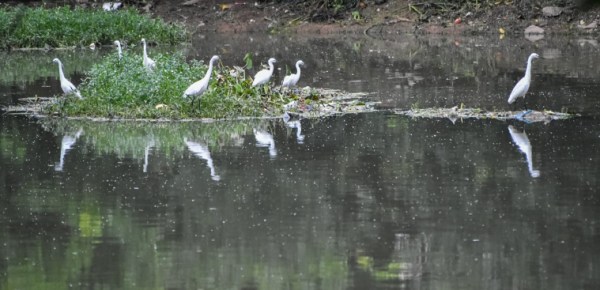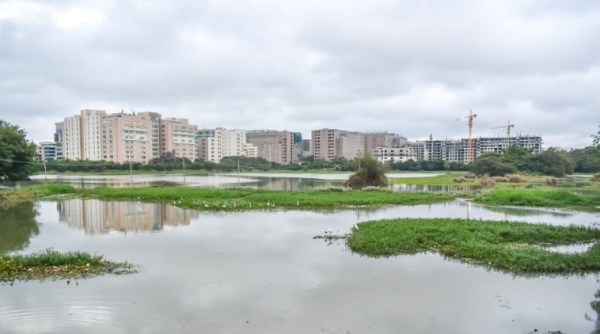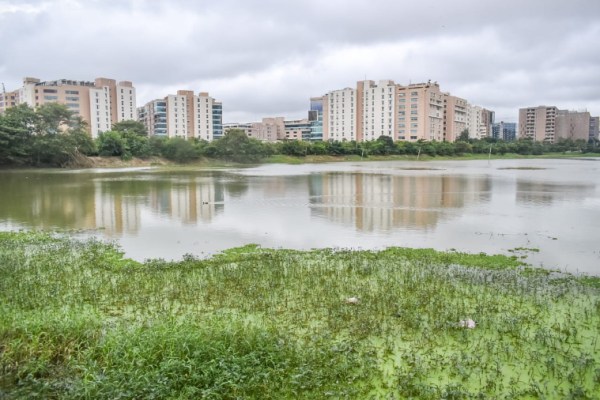Spread out across 61 acre behind the RMZ Ecospace near Sarjapura Road in Bangalore East, Saul Kere is one of the largest lakes in the area. According to a list released by the Bruhat Bengaluru Mahanagara Palike (BBMP) on Friday, it was one of the 126 lakes which overflowed following the downpour on September 5 in the city.
Located upstream, the Kaikondrahalli lake drains into the Saul Kere lake from where it enters Bellandur and finally flows into the Varthur lake.
 Birds at the Saul Kere lake. (Express photo by Jithendra M.)
Birds at the Saul Kere lake. (Express photo by Jithendra M.)
Experts pointed out that the water holding capacity of the lake being not good is one of the major reasons behind the overflowing of the lake. In 2017 as well, Saul Kere had breached, leading to the inundation of the nearby areas.
A volunteer with the non-profit organisation MAPSAS (Mahadevapura Parisara Samrakshane Mattu Abhivrudhi Samiti), that works towards rejuvenation of lakes, on the condition of anonymity said, “The rejuvenation of this lake was started somewhere in 2015-16 but was never completed. The rejuvenation of the lake usually includes desilting of the lake so that the water holding capacity of the water body increases but it did not happen completely.”
The volunteer added, “We continued fighting for the lake asking the authorities to desilt the lake. The water holding capacity of the lake needs an urgent fixing. The desilting of this lake should have happened four-five years ago. We recommended the authorities not to commission a sewage treatment plant (STP) because it involves a lot of maintenance and costs a lot but the Urban Development Department went ahead and allotted money for this. Money is not being used at places where it should be used. The construction of the STP has already started.”
 According to a list released by BBMP, the lake was one of the 126 which overflowed following the downpour on September 5 in the city. (Express photo by Jithendra M.)
According to a list released by BBMP, the lake was one of the 126 which overflowed following the downpour on September 5 in the city. (Express photo by Jithendra M.)
The volunteer also pointed out that the Kaikondrahalli lake, which was rejuvenated a few years ago and received applause from the NITI Aayog, is in shambles today. “The government presented Kaikondrahalli lake as an example of how a lake should be rejuvenated. The Union government showered praises. Just look at it and see it today. The lake’s bund has been broken by the people in the neighbourhood and it receives sewage,” he added.
Lake activist Jagadeesh Reddy said, “There are flaws with the rejuvenation of this lake. The lake bund was created scientifically. Saul Kere receives water from upstream lakes and in between this the drains are encroached which is one of the reasons behind the flooding of the lake. From this lake, the water through the canal enters Bellandur lake and ultimately enters Varthur lake but this canal too has been narrowed down.”
Co-founder of Friends of Lakes (a citizens’ collective), Ram Prasad said, “The way the restoration was carried out is haunting us now. The water holding capacity of this lake is not good. It seems the hydrogeological carrying capacity of the lake was not taken into consideration while carrying out the rejuvenation.”
 Experts pointed out that the water holding capacity of the lake being not good is one of the major reasons behind the overflowing of the lake. (Express photo by Jithendra M.)
Experts pointed out that the water holding capacity of the lake being not good is one of the major reasons behind the overflowing of the lake. (Express photo by Jithendra M.)
Joy V R, secretary of Sarjapura Resident Welfare Association (RWA), stays outside BBMP limits in Sarjapura. While his area remained unaffected in the heavy downpour, he said the authorities should free the canals of blockage or else someday his area will also face the same wrath.
He added, “We have 26 water bodies here in Sarjapura and we are fighting for their restoration. But the rajakaluves (storm water drains) leading to these lakes should be cleared of blockages. If this happens then no lake will overflow. The recent flooding happened due to blockages in the canals. The interconnectivity between the lakes through the storm water drains should be established in order to avoid overflowing.”